The first part in a series of articles exploring mixed, Co- and female Freemasonry, and how the fraternity and its members helped progress the emancipation and rights of women.
Part 1: The Beginnings – Lodges of Adoption, Co-Masonry and Women’s Orders
Freemasonry is an organisation that espouses equality; its very tenets promote the acceptance and tolerance of all fellow humans.
So, it follows that in the past there should have not only been support for, but direct involvement by Freemasons in the fight for women’s rights, suffrage and the struggle for equality.
Since the 1723 Constitutions of English Freemasonry were established, membership for women has been proscribed.
Outside of this jurisdiction, and especially in France, other Masonic Orders not only embraced equality of the sexes and allowed membership of both but eventually several Orders fragmented, became separate, and exclusively female.

Lodge of Adoption
IMAGE LINKED: wikimedia Attribution 4.0 International (CC BY 4.0)
Masonic Lodges of Adoption, where men and women were both able to join and participate in rituals, albeit – most often – separate ceremonies for each sex.
These Adoptive lodges were originally associated with an established Masonic Craft lodge – hence the term ‘adoptive’ – with male members officiating at the ceremonies of the wives, sisters, and daughters of Masons.
By 1774, these lodges had grown in number, so the regulatory body for French Freemasonry, the Grand Orient de France, consolidated Adoptive Freemasonry and established it as a specific Rite of Adoption consisting of four degrees.
However, it was decreed that for each female officer there was a male counterpart, with no ceremonies taking place unless a Mason from a male Order was present.
This form of Freemasonry continued for many years until a schism occurred between members of the Grand Orient of France and the Supreme Council of France.
Twelve lodges broke away and founded Grande Loge Symbolique Ecossaise (GLSE). One of these lodges, Les Libres Penseurs (The Free Thinkers) in Le Pecq, reserved in its charter the right to initiate women as Freemasons, proclaiming the essential equality of man and woman.
During this era in France there was a strong uprising in support of the rights of women, and suffrage, including the right to vote in political elections.
One prominent activist was Maria Deraisemes, a highly educated author. Maria was initiated into Les Libres Penseurs on 14 January 1882.
At her initiation, M. Houbron, Master of Les Libres Penseurs lodge declared:
We are about to consecrate one of the greatest humanitarian principles, that of Equality.
By admitting a woman into our Mysteries, we proclaim the Equality of the two human beings who together incur in the propagation of the human race … [since woman is the child’s first leader] to do away with her prejudices by the moral teachings and the light of Masonry would be to bring about by peaceful means true social emancipation. [i]
A year later Deraisemes and Georges Martin – a founder member of GLSE – founded the first mixed-sex lodge Grande Loge Symbolique Écossaise ‘Le Droit Humain’.
This mother lodge became the basis for the creation of Le Droit Humain Lodge, the origins of Co-Masonry, which grew into the International Order of Freemasonry Le Droit Humain.

Left:Maria Deraismes – By Unknown author
Right: Georges Martin – Freemason, founder of Le Droit Humain
IMAGE LINKED: wikimedia Attribution 4.0 International (CC BY 4.0)
The term ‘féminisme’ (feminism) originated in France – Charles Fourier, a utopian socialist and French philosopher, is credited with having coined the term in 1837 – it defined the ideology of women’s emancipation.
‘Relational feminism’ (aka ‘maternal feminism’) is described by historian Karen Offen, who relates that ‘whilst men and women are fundamentally different, the distinctive contribution that women make to society, specifically as women, entitle them to equal rights’ [ii].
This rationale is applied to Freemasonry by James Smith Allen in his paper entitled ‘Freemason Women in Modern France, 1725-1940’ [iii], where he states that:
Freemasonry’s affinity for gender complementarity, a major feature of relational feminism, was no accident…
…The Masonic promotion of equality in sexual difference was a singular affirmation of women’s biologically defined social duties as wives and mothers, of course, but also of their special contribution to public life is more than guardians of personal morality.
The constraints imposed on women by Jean-Jacques Rousseau’s eighteenth-century domestic ideology eventually gave way to new responsibilities for them outside the home in everyday nineteenth-and twentieth-century practice well beyond Freemasonry itself.
In part for this reason. Bourgeois women’s participation in Masonic activities was at once relational and feminist, symbolic and genuine. circumscribed and yet powerful enough to give new meaning to women’s sociability as distinct from men’s.
It would be a fair estimate to say that the struggle for women to be included into Freemasonry echoed the struggle for women’s rights during the late nineteenth century; there were to be many intellectual women who would be drawn to the ethics and ideologies of mixed-Masonry.
One of those women was Annie Besant, the socialist radical feminist, and Theosophist. Freemasonry, and Co-Masonry in particular would have strongly appealed to Besant’s passion for women’s rights and the perfection of the brotherhood of man.
She saw Freemasonry as a ‘movement which practised true brotherhood, in which women and men worked side by side for the perfecting of humanity’.
Besant, along with six friends, including feminist and suffragette Ursula Bright and her daughter, travelled to Paris and were initiated, passed and raised into the first three degrees.
On her return to London, Besant, along with officers of the Supreme Council of the French Maçonnerie Mixte (today known as The International Order of Freemasonry for Men and Women, Le Droit Humain) formed the Order of Universal Co-Freemasonry in Great Britain and the British Dependencies.
On 26 September 1902, the first British lodge Droit Humain, No.6 Human Duty was consecrated in London.
Besant remained leader of the Order until her death in 1933.
Thus far, we can see how the progress of women’s rights had worked in tandem with Freemasonry to create its new mixed Orders.
This was in part due to another organisation that was of huge influence on both Freemasons and the emancipation of women – the Theosophical Society (TS).
Annie Besant was heavily involved in the Society, and it was she and her fellow Theosophists who brought Co-Masonry to Britain and nurtured it; many of the teachings of Theosophy were incorporated into it.
However, in 1908, yet another schism occurred when some members within Co-Masonry wanted to distance themselves from some aspects of the Maçonnerie Mixte and conform more to the Freemasonry of the United Grand Lodge of England, and so a new grand lodge was formed called the Honourable Fraternity of Antient Masonry (HFAM).
The first Grand Master was Rev Dr William Frederick Cobb but from 1912, all successive Grand Masters have been women. Originally the Order allowed both men and women to take part but by the early 1920s, the decision was taken to restrict entrance to women and men were no longer permitted to visit.
At the time there were several men still in positions of office, but by 1935 the Order had become exclusively female.

This was not to be the last schism, for in 1913, the subject of the Holy Royal Arch reared its head – similar to the situation of the Antients and the Moderns before the Union in the eighteenth century – and yet another split occurred.
Those members who wished to include the Royal Arch, broke away to form the female-only Honourable Fraternity of Ancient Freemasons (HFAF), and just like the Antients and the Moderns, there became two Grand Lodges in parallel.
To avoid confusion between the two women’s Orders, in 1958, the HFAM added ‘Order of Women Freemasons’ to their title.

In Part 2 – A Father of Suffragettes, and the Women Freemasons who helped change the world.
Footnotes
References
[i] C.G. Trew, ‘The History of our Order’; paper given at the 70th anniversary of its Founding at the Occasional Lodge on 21 May 1972, The International Freemason (Autumn 1972), p. 8. Cited in Pilcher-Dayton, A. ‘Women Freemasons and feminist causes 1908-1935: the case of the Honourable Fraternity of Antient Masonry.’ (2012).p.26.
[ii] Offen, Karen. ‘Defining Feminism: A Comparative Historical Approach.’ Signs, 14, no. 1 (1988): 119-157. Cited in: Trott, Catherine, ‘Relational Feminism’, Towards Emancipation https://hist259.web.unc.edu/relational-feminism/ accesses 28/06/2021.
[iii] Allen, James Smith. ‘Sisters of Another Sort: Freemason Women in Modern France, 1725–1940. The Journal of Modern History, vol. 75, no. 4, 2003, pp. 783–835. JSTOR, www.jstor.org/stable/10.1086/383354. Accessed 28 June 2021.
OTHER SOURCES:
Wikipedia
Article by: Philippa Lee. Editor

Philippa Lee (writes as Philippa Faulks) is the author of eight books, an editor and researcher.
Philippa was initiated into the Honourable Fraternity of Ancient Freemasons (HFAF) in 2014.
Her specialism is ancient Egypt, Freemasonry, comparative religions and social history. She has several books in progress on the subject of ancient and modern Egypt. Selection of Books Online at Amazon

Women’s Agency and Rituals in Mixed and Female Masonic Orders
By: Alexandra Heidle (Author), Jan Snoek (Author)
Women have been structurally part of the masonic enterprise from at least the middle of the 18th century.
Yet, little is known about the ways in which they themselves obtained and exercised power to influence the systems they were involved in, in order to adapt them to be more appropriate to their needs.
This volume intends to concentrate on two aspects: Women’s agency (i.e. the power women gained and exercised in this context) and rituals (i.e. the role of men and women in changing and shaping the rituals women work with).
These two aspects are closely related, since it requires some agency to realise changes in existing rituals.
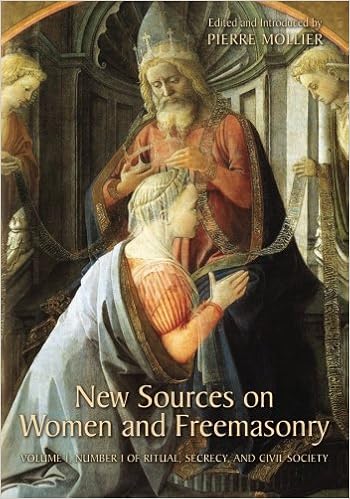
New Sources on Women and Freemasonry
By: Pierre Mollier (Author, Editor)
There has been a great lack in international scholarship concerned with ritual and secrecy because so much of the good work is being done in languages that the mono-lingual English-speaking world has no idea exist.
The strength of the articles in this collection will come as a considerable surprise even to experts in the field, because the research in Europe is very advanced and frankly is of such high quality that those who are not linguists should look to their laurels.
Much is being done in discovering un-mined material in archives and the selections for this volume are a feast of new bibliographical references.
Recent Articles: Women Freemasons
 Freemasonry and Women's Rights - P4 The Freemason judge who ruled women were 'persons' |
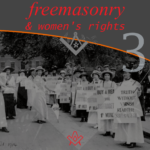 Freemasonry and Women's Rights - P3 Who embraced and influenced the women’s rights and suffragette movements in Europe in the late nineteenth and early twentieth century |
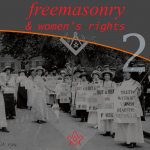 Freemasonry and Women's Rights - P2 Second part, in the introductory series exploring the history of mixed, Co- and female Freemasonry, and how the fraternity and its members helped progress the emancipation and rights of women. |
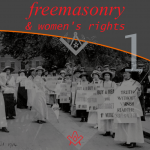 Freemasonry and Women's Rights - P1 A two-part introductory series exploring the history of mixed, Co- and female Freemasonry, and how the fraternity and its members helped progress the emancipation and rights of women. |
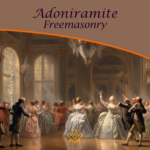 Adoniramite Freemasonry, also known as Adoptive Freemasonry, emerged in 18th-century France as a unique initiation system for women. Mimicking the secrecy and symbolism of regular Freemasonry, these Lodges of Adoption attracted noblewomen, literary figures, and even royalty. Explore the origins, rituals, and controversies surrounding this intriguing branch of Freemasonry. |
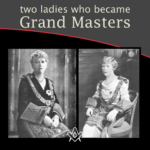 Two ladies who became Grand Masters Who were the two ladies, mother and daughter who become Grand Masters of Honourable Fraternity of Ancient Freemasons |
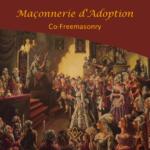 A look at Adoptive Lodges that were established in France for the initiation of females; a short Extract from the Encyclopedia Of Freemasonry |
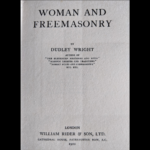 Published in 1922, this interesting, and whimsical book was penned by Dudley Wright |
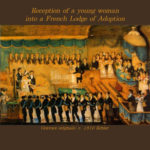 Look at the History of Women in Freemasonry. Although Several women had been introduced to Freemasonry prior to the 18th century, it was more by accident than invitation. |
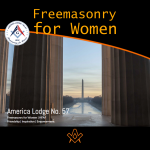 The Great American Experiment, a film by HFAF documenting the Consecration and Installation of Officers of America Lodge No. 57 on May 25, 2019 |
masonic knowledge
to be a better citizen of the world
share the square with two brothers

click image to open email app on mobile device









